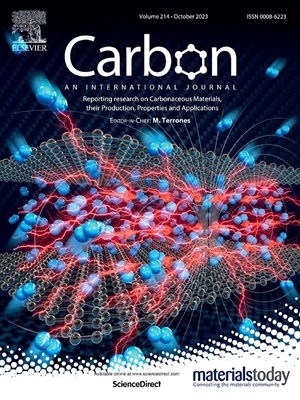Microwave absorption of the synthesized 3D Ni@N-Doped porous carbon foams for relatively low frequency range
IF 10.5
2区 材料科学
Q1 CHEMISTRY, PHYSICAL
引用次数: 0
Abstract
A facile and scalable polymer bubbling technique was used to fabricate three-dimensional nickel-embedded nitrogen-doped porous carbon foams (3D Ni@NPCFs) exhibiting high-performance electromagnetic wave absorption. The 3D Ni@NPCFs were characterized by their unique 3D interconnected porosity and the cooperative effect of conductive magnetic Ni nanoparticles and nitrogen incorporation. The optimal sample achieved reflection loss (RL) of −47.20 dB at 6.05 GHz and an effective absorption bandwidth (EAB) of 7.4 GHz within the absorber thickness of 3.0 mm. This superior performance is attributed to the unprecedented synergistic interplay between the tailored 3D porous network, which facilitates multiple scattering and prolonged wave propagation, and the embedded Ni nanoparticles coupled with nitrogen doping, which enhances both the magnetic and dielectric losses. Furthermore, the optimal sample demonstrated a simulated radar cross-sectional reduction of up to 28.43 dBm2. The 3D Ni@NPCFs show great promise as high-performance absorbers for electromagnetic protection applications.

合成的三维Ni@N-Doped多孔泡沫碳在较低频率范围内的微波吸收
采用一种简单、可扩展的聚合物鼓泡技术制备了三维含镍氮掺杂多孔碳泡沫材料(3D Ni@NPCFs),具有高性能的电磁波吸收性能。三维Ni@NPCFs以其独特的三维互联孔隙度和导电磁性Ni纳米颗粒与氮掺杂的协同效应为特征。最佳样品在6.05 GHz时的反射损耗(RL)为- 47.20 dB,在吸收器厚度为3.0 mm时的有效吸收带宽(EAB)为7.4 GHz。这种优异的性能归功于定制的3D多孔网络和嵌入的Ni纳米颗粒与氮掺杂之间前所未有的协同相互作用,前者促进了多次散射和延长波传播,后者增强了磁性和介电损耗。此外,最优样品显示模拟雷达横截面减少高达28.43 dBm2。3D Ni@NPCFs作为电磁保护应用的高性能吸收剂显示出巨大的前景。
本文章由计算机程序翻译,如有差异,请以英文原文为准。
求助全文
约1分钟内获得全文
求助全文
来源期刊

Carbon
工程技术-材料科学:综合
CiteScore
20.80
自引率
7.30%
发文量
0
审稿时长
23 days
期刊介绍:
The journal Carbon is an international multidisciplinary forum for communicating scientific advances in the field of carbon materials. It reports new findings related to the formation, structure, properties, behaviors, and technological applications of carbons. Carbons are a broad class of ordered or disordered solid phases composed primarily of elemental carbon, including but not limited to carbon black, carbon fibers and filaments, carbon nanotubes, diamond and diamond-like carbon, fullerenes, glassy carbon, graphite, graphene, graphene-oxide, porous carbons, pyrolytic carbon, and other sp2 and non-sp2 hybridized carbon systems. Carbon is the companion title to the open access journal Carbon Trends. Relevant application areas for carbon materials include biology and medicine, catalysis, electronic, optoelectronic, spintronic, high-frequency, and photonic devices, energy storage and conversion systems, environmental applications and water treatment, smart materials and systems, and structural and thermal applications.
 求助内容:
求助内容: 应助结果提醒方式:
应助结果提醒方式:


